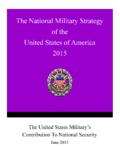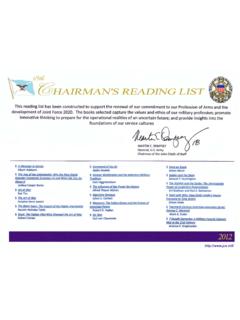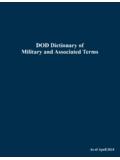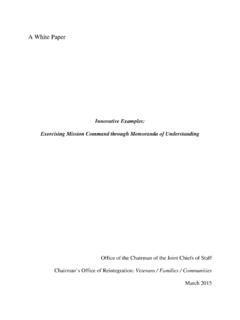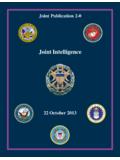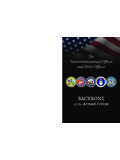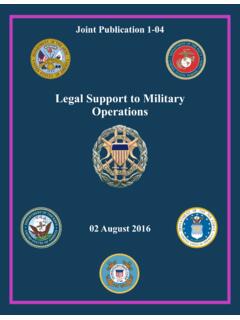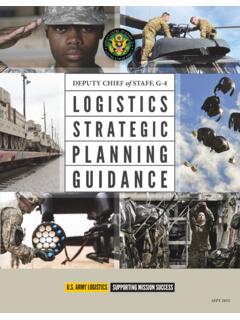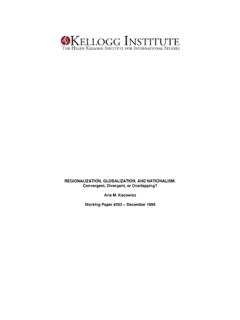Transcription of JDN 1-19, Competition Continuum, 3 June 2019
1 Joint Doctrine Note 1-19 Competition Continuum03 June 2019 Unclassified i PREFACE 1. Scope This joint doctrine note (JDN) describes the Competition continuum ; discusses some of its implications for how the joint force campaigns; and describes aspects of campaigning through cooperation, adversarial Competition below armed conflict, and armed conflict. 2. Purpose A JDN is a publication intended to facilitate information sharing on problems and potential solutions as a supporting effort of formal joint doctrine development and revision. This publication addresses potential gaps in joint doctrine identified by the Joint Concept for Integrated Campaigning (JCIC). Many JCIC terms and ideas have already been incorporated into joint and Service concepts, training, education, and processes. This publication is the first step in the further refinement of those ideas from the JCIC into doctrine. 3. Application The guidance in this JDN is not authoritative.
2 If conflicts arise between the contents of this JDN and a joint publication (JP), the JP will take precedence for the activities of joint forces, unless the Chairman of the Joint Chiefs of Staff, in coordination with the other members of the Joint Chiefs of Staff, has provided more current and specific guidance. DANIEL J. O DONOHUE Lieutenant General, USMC Director, Joint Force Development Preface ii JDN 1-19 Intentionally Blank iii TABLE OF CONTENTS EXECUTIVE SUMMARY ..v Competition continuum Introduction ..1 The Competition continuum ..2 Competition continuum and Integrated Campaigning ..4 Campaigning Through Cooperation ..7 Campaigning Through Competition Below Armed Campaigning Through Armed Conflict ..9 The Competition continuum and Deterrence ..10 Table of Contents iv JDN 1-19 Intentionally Blank v EXECUTIVE SUMMARY Introduces the Competition continuum . Discusses the Competition continuum and integrated campaigning.
3 Outlines campaigning through cooperation, Competition below armed conflict, and armed conflict. Discusses the Competition continuum and deterrence. The Competition continuum Competition is a fundamental aspect of international relations. As states and non-state actors seek to protect and advance their own interests, they continually compete for diplomatic, economic, and strategic advantage. The joint force, however, employs many constructs and procedures that reflect an artificial distinction between an environment of armed conflict and peace without significant military Competition . For the joint force to play its role in advancing national interests, it must adopt a better framework for understanding, describing, and participating within a competitive operational environment. Rather than a world either at peace or at war, the Competition continuum describes a world of enduring Competition conducted through a mixture of cooperation, Competition below armed conflict, and armed conflict.
4 Competition continuum and Integrated Campaigning Integrated campaigning requires the skillful combination of cooperation, Competition below armed conflict, and, when appropriate, armed conflict in conjunction with diplomatic, informational, military, and economic efforts to achieve and sustain strategic objectives. To accommodate the inevitable shifts in policy over any extended period, joint force commanders Executive Summary vi JDN 1-19 and planners adopt a mindset of campaigning rather than of campaigns. This is a flexible approach that recognizes joint force activities of all kinds not just armed conflict should be continually adapted in response to evolving strategic conditions and policy objectives. Campaigning Through Cooperation Campaigning through cooperation is usually an enduring activity with no discrete start or end point; the relationship with the ally or partner is in place and will continue for the foreseeable future.
5 In some cases, however, cooperation in specific areas with a partner whose overall relationship with the US is neutral, or even adversarial, may be necessary. Cooperative activities can take many forms, from security force assistance with a partner in a quiet region to multinational operations and activities in an armed conflict. Campaigning Through Competition Below Armed Conflict Competition below armed conflict tends to occur over extended periods of time. In comparison to armed conflict, actions are often more indirect and the expenditure of resources less intense, thus allowing for a more protracted effort. As an inherently constrained and measured approach, it is not generally used by competitors requiring quick results. For the joint force to successfully campaign through Competition below armed conflict, it should adopt a similar long-term approach but one supple enough to react to rapid changes in the political, diplomatic, and strategic environment.
6 Campaigning Through Armed Conflict One implication of the Competition continuum is that it is not solely sufficient to excel in campaigning through armed conflict. Even in an international armed conflict, success requires the skillful application of both cooperation and Competition below armed conflict. If these are ignored or treated as strictly ancillary to the armed Executive Summary vii conflict effort, then the joint force is at increased risk for failure to meet some or all of the desired objectives. Commanders and staffs should be aware of the interrelated nature of these various elements. The joint force should also campaign in armed conflict with a long-term view toward the transition period following the end of the main period of armed conflict. Rarely do wars end with a complete end of armed conflict. Wars disrupt political, social, and economic structures, networks, and institutions to the point it is often impossible to simply return to a pre-conflict state.
7 The Competition continuum and Deterrence Deterrence applies across the Competition continuum , though in different fashions according to the situation. Within armed conflict, there are many aspects to deterrence. The joint force seeks to deter a conventional attack against a partner or ally, but even if that occurs, it is still possible to deter the attacker from expanding the war geographically or from using certain forms of weapons. Deterrence in Competition below armed conflict is similarly nuanced and perhaps harder to judge. As with armed conflict, the joint force can deter future actions in Competition below armed conflict by effectively responding to current challenges. Executive Summary viii JDN 1-19 Intentionally Blank 1 Competition continuum 1. Introduction a. Competition is a fundamental aspect of international relations. As states and non-state actors seek to protect and advance their own interests, they continually compete for diplomatic, economic, and strategic advantage.
8 The Cold War was a clear example of the many facets of international Competition . The US and the Soviet Union competed with each other in numerous ways ( , for greater influence in international organizations, for the next great achievement in space, and for more medals won at the Olympics). Rather than engage in direct armed conflict with the other, each state fought through and with proxies as an indirect means to gain advantage. Yet, the two superpowers also cooperated, such as when both backed actions in the United Nations Security Council. And, just as competitors can cooperate, friendly states can compete. Within an alliance, individual countries naturally seek to tilt policy in the direction most advantageous for their long-term interests. Diplomats, trade representatives, and other members of the US Government who routinely interact with foreign actors intuitively recognize that any strategic relationship mixes elements of both Competition and cooperation.
9 B. The joint force, however, employs many constructs and procedures that reflect an artificial distinction between an environment of armed conflict and peace without significant military Competition . There are some reasons for this. The Constitution, domestic law, and international law all use the peace/war distinction as a means to regulate the act of employing violence on behalf of the state. Maintaining a sharp distinction between peace and war also has purposes within the Department of Defense. The designation of a state of war (or armed conflict) justifies the expenditure of resources, the imposition of hardship on Service members, and the acceptance of risks far beyond what would normally be acceptable. For an institution as large as the Department of Defense, it is far easier to treat these matters in a few distinct categories rather than a complex sliding scale. Though, the joint force has long been conducting competitive activities outside of armed conflict, the previous operational environment was not so competitive that, in most cases, the legal and institutional advantages of the peace/war binary model outweighed the disadvantages created by its artificial simplicity.
10 C. The current operational environment requires a more nuanced model. geopolitical rivals such as Russia and China employ a mixture of instruments of national power to achieve significant strategic advantages in a manner calculated not to trigger our legal or institutional thresholds for armed conflict. For the joint force to play its role in advancing national interests, Our traditional way that we differentiate between peace and war is insufficient to [the dynamic of Competition below armed conflict]. We think of being at peace or adversaries don t think that way. General Joseph F. Dunford, Jr. Chairman of the Joint Chiefs of Staff 21 September and 5 October 2016 Competition continuum 2 JDN 1-19 it must adopt a better framework for understanding, describing, and participating within a competitive operational environment. 2. The Competition continuum a. Rather than a world either at peace or at war, the Competition continuum describes a world of enduring Competition conducted through a mixture of cooperation, Competition below armed conflict, and armed conflict.

